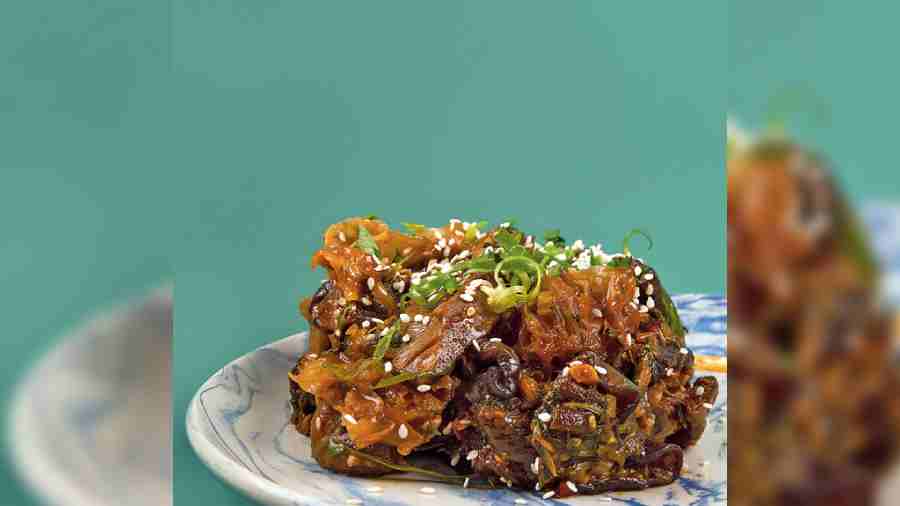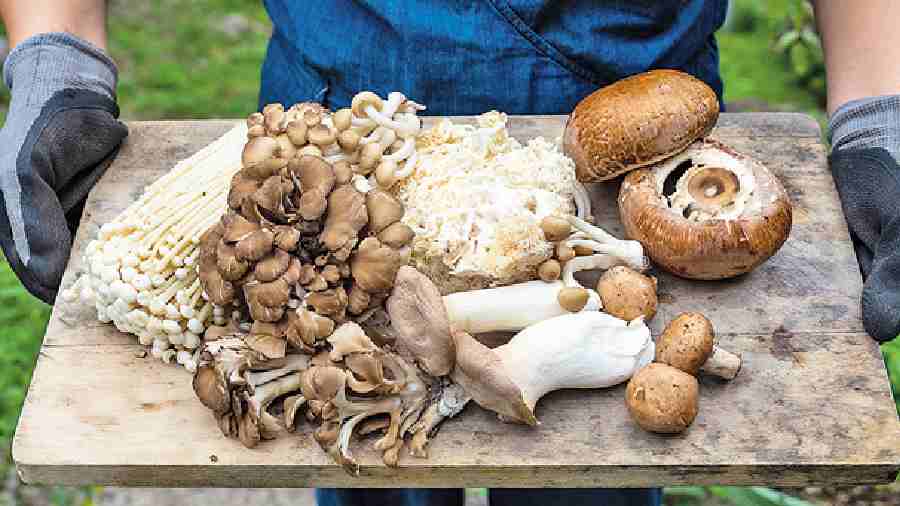My seven-year-old is an encyclopedia of knowledge, and got into a very interesting conversation with me the other day when I asked him to eat his vegetables. “But, Mama, mushrooms are not vegetables, they’re fungi!” said he, with a flair of hands expressing his disbelief at my ignorance.
“I know,” said I, “but you still have to eat them.” Mushrooms are a hot favourite at my place, so his plate was clean in no time.
The saying goes, eschew all the white products from your plate: refined flours, white sugar, and white bread... but mushrooms are a definite exception to the rule, and for many reasons.
All mushrooms are fungi, and around 38,000 varieties of them are available! But, only about 20 species are edible. They grow above the ground in a multitude of environment, usually soil or wood. They tend to pop up in the wild ever so often. However, the ones that make their way to us are usually the cultivated kinds.
These are a few of my favourite mushrooms:
1) White Button Mushroom: These are the most ubiquitous mushrooms found in India. They look exactly like their name: white buttons. Not very pungent or intensely flavoured, these mushrooms lend themselves well to simple preparations.
2) Cremini Mushrooms: They’re the brown cousins of the white button mushroom. Until 1926, all button mushrooms were brown, when a mushroom farmer found a cluster of white buttons growing in his bed. The cremini variety is a little more intense than its white cousin, imparting a lovely umami flavour.
3) Portobello Mushrooms: These are much larger than cremini or button mushrooms and have a more meaty texture while retaining a mild flavour. They have their cap fully open, exposing the dark gills underneath. They are large enough to be used as vegetarian/vegan burgers or to be stuffed with other ingredients, and are often baked instead of fried.
4) Oyster Mushrooms: These may look like oysters, but they don’t taste like them. Oyster mushrooms are one of the largest types of edible mushrooms, and are usually cultivated on decaying wood. It has a slightly sweet, anise-like smell and a tender flesh and velvety texture. They have a mild flavour that works beautifully with light sauces.
5) King Oyster Mushrooms: The King Trumpet or king oyster mushrooms are the largest of the oyster mushroom genus with a meaty edible stalk. They grow around 10-15cm in length, and have a long shelf life in the fridge. Their texture is similar to abalone or scallops, making them an interesting option for vegetarians as a main course item.
6) Chanterelle Mushrooms: Rich flavoured, yellow-hued and tender textured, chanterelles are a vibrant and versatile variety of edible mushrooms. They have a distinctive peppery taste with a slightly sweet or fruity tinge.
7) Porcini Mushrooms: Also known as Cep mushrooms, porcini mushrooms are most commonly used in Italian cooking, with a slightly creamy, nutty flavour, they can grow up to 10 inches across. However, most porcini mushrooms are harvested to around 3cm in size. Mostly sold dried, these mushrooms can be rehydrated by soaking them in hot water.
8) Morels : Morels are a type of wild mushroom, and are easy to distinguish by their exterior, which resembles a honeycomb. The inside of a morel is hollow and white. They vary in size and shape, going from oblong to bulbous and their colour from gray to a light yellow. Morels have a meatier texture compared to most mushrooms, and are coveted by chefs and mushroom enthusiasts the world over.
The reason for this is morels only grow in the wild. They cannot be cultivated like regular mushrooms, making morels a rarity. Found in warm, wet conditions, morels are usually harvested in spring, by foragers. They are hard to cultivate, almost impossible, which means they can only be hand-picked by foragers, in the short growing season — March to June. Morels are also highly perishable, since they are hollow in the centre and do not hold up well during travel. Dried morels, however, are available the year round, and can be easily rehydrated with water.
Fit Check
Agreed, mushrooms and morels have this more-ish, umami aspect to them, which other ‘vegetables’ just don’t, and the reason behind this is the compound called glutamate. Mushrooms are a nutritional powerhouse, and can help keep you healthy and young.
Mushrooms contain ergo sterol, and are a great plant source of Vitamin D, and can increase their concentration by exposure to UV radiation from either sunlight or even a UV lamp. You can up the Vitamin D content of mushrooms by leaving them out on your counter near a window, a mere 10 minutes before cooking them.
Beta-glucan, a soluble fibre found in mushrooms, helps activate parts of your immune system and increases your body’s ability to fight off diseases. Along with B vitamins and selenium, mushrooms make a good case for boosting immunity. Beta-glucan, along with other plant nutrients found in mushrooms, is also pre-biotic and assists good gut health.
Certain kinds of mushrooms, rich in polyphenols, like the Lion’s Mane, are known to ward off and ameliorate neurogenerative diseases like Alzheimer’s. These are normally consumed in powder form and are credited as being medicinal. The potassium in mushrooms, even as common as the button mushroom, are helpful in lifting moods, and lower the risk of depression!
So much for mushrooms, but there’s more-ls! These wild mushrooms give a strong competition to their cultured cousins. At only 31 calories per 100g, they’re a great low-calorie cornucopia of goodness. They have a rich mineral content with high levels of copper, iron, manganese and zinc. Copper is one of the essential trace elements that assists with blood cell production.
Morels have the highest amount of Vitamin D among edible mushrooms and helps with bone growth and calcium metabolism. They also carry excellent amounts of B vitamins.
Truffles
Truffles have taken the world by storm! From pasta to chips and even ice cream, truffles are a flavour profile in themselves. Although truffles and mushrooms are both in the fungi kingdom, they are different in many ways. For starters, they grow in different places and thrive in different climates, and much like morels, are impossible to cultivate. In fact, one of the reasons truffles are so prized is because they are exclusively foraged. They grow underground for a few months each year, and it takes a lot of practice and a keen eye to spot them.
Italy is famous for its truffles, and regions in the north and centre of the country produce some of the best in the world.
Cooking mushrooms
Mushrooms, morels and truffles are all versatile produce and can be cooked in many ways. Some of my favourites are:
Mushrooms are tremendously multifaceted. They can be enjoyed raw, baked, grilled or even sautéed. My favourite is making a bisque with mushrooms. The aromatics infused with the umami flavour makes this a classic recipe.
Morels should be cooked as simply as possible to truly savour their flavour. I prefer to sauté mine in butter with a little garlic to extract the maximum flavour from them. Kashmiri cuisine has a heady morel curry which is also a personal favourite. Morels also pair beautifully with other springtime produce, such as asparagus and come together well in a risotto.
Truffles, in my opinion, should not be cooked at all. A shaving of good quality truffle atop a dish brings out the most exquisite taste. The cooking process tends to destroy its unique flavour, so best to use it just before serving!
Nutty, Earthy and DELISH!
The fungi family are truly gems of the Earth! With so many great options available, each meal can be elevated to new heights with the simple addition of these. At Paprika, we enjoy experimenting with different methods and ingredients. Whenever I want to eat light, I enjoy my white fungus salad, a light and delicious recipe that is also a party starter. We all have different recipes that are family heirlooms and I would love to know more about your favourite mushroom recipe.
Write to me at vidisha@paprika.net.in

Vidisha Bathwal is the founder of Paprika Gourmet, an exotic artisan catering service brand in Kolkata. She’s also a passionate foodie and a fitness enthusiast.
Mixed Mushroom Salad

Ingredients
- 1 pound mixed mushrooms, such as cremini, shiitake caps, oyster and/or beech, halved
- 1 small onion, halved and sliced
- 3tbsp extra-virgin olive oil, divided
- 1/4 tsp salt, divided
- 2 tbsp lemon juice
- 1 1/2tsp chopped fresh thyme, or 1/2tsp dried
- 1/4tsp ground pepper
- 3tbsp dry sherry
- 2 cloves garlic, minced
- 8 cups bitter salad greens, such as frisée, arugula and/or baby dandelion greens
- 2tbsp shaved Parmesan cheese
Method
Preheat oven to 450°F.
Toss mushrooms, onion, 1tbsp oil and 1/8tsp salt in a large bowl. Spread in an even layer on a large, rimmed baking sheet. Roast, stirring occasionally, until soft and golden brown, 15 to 20 minutes.
Meanwhile, whisk the remaining 2tbsp oil, lemon juice, thyme, 1/8tsp salt and pepper in the large bowl.
Remove the mushroom mixture from the oven. Immediately add sherry and garlic to the pan, stirring and scraping up any browned bits. Scrape the mixture into the bowl with the dressing. Add greens and toss to coat. Serve the salad sprinkled with Parmesan.
